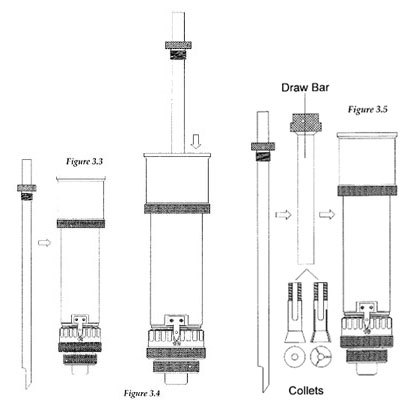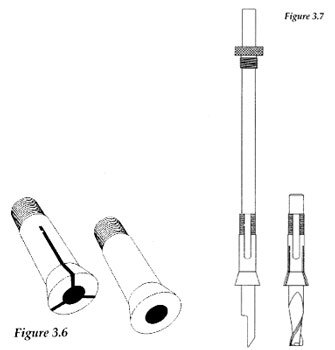Equipment: Spindles | Resources
Welcome to the JPPlus Resource Center!
Your resource for support for: Engraving | Sublimation | Toner Heat-Transfer | UV-LED & more!
Second only to the engraving table, the spindle is an extremely important part of the engraving system. This is true for manual as well as computerized engravers. Spindles are precision manufactured mechanical components that operate at variable speeds during rotary engraving. They use internal precision bearings that provide the rotary capability and support the rotating cutter during engraving. All spindles use some form of bearings and require special care and handling. See the section on equipment maintenance for more details.
TOP-LOAD VS. COLLET SPINDLES
To understand the differences between top-load and collet spindles, a little history and the possible uses of each type are important. Top-load spindles that accept drop-in cutters as shown in Figure 3.3 are generally standard equipment on most engraving systems. Since they are a standard, replacement parts are common and a wide range of cutter sizes is available. The single biggest reason why top-load spindles are so popular is that cutter changes are quick and easy. A full 90 percent of all spindles are the top load type. Under normal use, these spindles can last for several years and may never need bearing replacement. Typically you will find these spindles suitable for engraving in flexible plastic stock, rotating diamond applications, acrylic and softer metals.
On the other hand, bottom-load collet spindles offer distinct advantages in many engraving applications. Cutting tools generally confined to other industries can be used and in many cases the standard drop-in cutters can still be used as well. Cutters such as end-mills, drill bits, router bits and dremel tools, for example, may be used providing the broadest possible choice in tool selection. To determine which spindle you should use is a matter of determining what materials you will cut at least 80 percent of the time. Heavy industrial applications demand a collet spindle.
Figure 3.4 shows a typical top-load spindle with a 6.5" drop-in cutter. The cutter is inserted into a precision-machined center shaft, making it necessary for the inside diameter of the center shaft to be slightly larger than the cutter shank diameter. Since clearance is necessary to insert the cutter, a gap must exist. Although this gap is small, some play in the cutter is inevitable. Also, given the fact that the cutter is held at the top of the spindle (as opposed to the bottom like that of the collet version), more play is also inevitable at the bottom of the cutter. This play, though minute, results in cutter wobble and vibration which in turn means chipped or broken cutters, and sometimes, less than desirable letter quality. Over time, with the insertion and removal of cutters, this play can increase. At some point the center shaft may need to be replaced. Additionally, if undetected and not repaired this vibration will cause premature wear in the spindle bearings causing them to need to be replaced sooner rather than later. Although a problem in some instances, top load spindles continue to be the preferred choice of all engraving equipment suppliers and engravers. In those cases where cutter play is a problem, the collet spindle design is the answer.

Figure 3.5 shows the collet spindle shaft and the related draw-bar and collet. Imagine a short 2" cutter inserted from the bottom. With the draw-bar not tightened the cutter would simply fall out. When the draw-bar is tightened, it draws the collet up into the tapered spindle shaft and pinches it, holding the cutter securely in place and dramatically reducing vibration at the cutter tip.
The best analogy live heard is this: Try writing your name with a pencil, only hold it by the eraser instead of the way you normally do, close to the pencil tip. I think you’ll agree that using the eraser method results in a signature that looks more like hieroglyphics.
Here are the pros and cons of these two most common spindle types used in our industry:
- If you’re a trophy or plaque supplier, if you switch cutters often, or if you only own one engraving system, a collet spindle may not be a good choice for you.
- If you like to experiment with different looks, need to drill holes, or want to use your machine as a mini-router, then a collet spindle is the way to go.
- Heavier industrial applications, especially deep cutting metals like stainless steel or brass, can benefit from the rigidity of a collet spindle.
- Collet spindles require three hands to load and a little practice but are well worth the investment if you have applications where varied tools are important. Applications include reverse engraving in acrylics, 3-D jobs, cutting wood signs, or light machining.
- If you feel that switching between a top-load and collet type spindle is not an inconvenience then both may be helpful to have. However, changing spindles during a busy production schedule can take from 5-15 minutes for each change-over which can seriously slow down productivity.
- A collet spindle will cost you about $450- $850.
There is one more element about collet spindles that’s necessary to understand: there are actually two different types. The traditional split collet and the solid collet version (See Figure 3.6). The split collet grabs the short cutter when the draw-bar is tightened. On the other hand, a solid collet is used when longer top load cutters are needed. The solid collet cannot collapse and grab the cutter; therefore, it acts much the same as a top-load spindle shaft. The benefit, of course, is that both top-load and bottom-load cutters can be used in the same spindle. Also, by changing the size of the collet (1/8", 11/64", 1/4", 3/16", 5/16", 3mm, 4mm, 6mm) you gain the ability to select various cutters having different shank sizes (See Figure 3.7).

The Engravers' Bible © 1999 by Rich Zydonik/National Business Media, Inc. Printed and Bound in the United States of America. All rights reserved. No part of this self-study manual may be reproduced in any form without permission in writing from the author/publisher. Additional legal, financial and professional management advice and/or assistance are encouraged.
